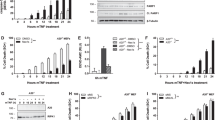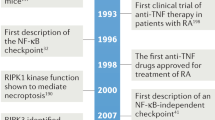Abstract
The transcription factor NF-κB is an important regulator of gene expression during immune and inflammatory responses, and can also protect against apoptosis. Here we show that endothelial cells undergo apoptosis when deprived of growth factors. Surviving viable cells exhibit increased activity of NF-κB, whereas apoptotic cells show caspase-mediated cleavage of the NF-κB p65/RelA subunit. This cleavage leads to loss of carboxy-terminal transactivation domains and a transcriptionally inactive p65 molecule. The truncated p65 acts as a dominant-negative inhibitor of NF-κB, promoting apoptosis, whereas an uncleavable, caspase-resistant p65 protects the cells from apoptosis. The generation of a dominant-negative fragment of p65 during apoptosis may be an efficient pro-apoptotic feedback mechanism between caspase activation and NF-κB inactivation.
This is a preview of subscription content, access via your institution
Access options
Subscribe to this journal
Receive 12 print issues and online access
$209.00 per year
only $17.42 per issue
Buy this article
- Purchase on Springer Link
- Instant access to full article PDF
Prices may be subject to local taxes which are calculated during checkout







Similar content being viewed by others
References
Baeuerle, P. A. & Baltimore, D. NF-κB: Ten years after. Cell 87, 13–20 (1996).
Baeuerle, P. A. & Henkel, T. Function and activation of NF-κB in the immune system. Annu. Rev. Immunol. 12, 141–179 (1994).
Baldwin, A. S. Jr The NF-κB and IκB proteins: new discoveries and insights. Annu. Rev. Immunol. 14, 649–683 (1996).
Beg, A. A., Sha, W. C., Bronson, R. T., Ghosh, S. & Baltimore, D. Embryonic lethality and liver degeneration in mice lacking the RelA component of NF-κB. Nature 376, 167–170 (1995).
Beg, A. A. & Baltimore, D. An essential role for NF-κB in preventing TNF-α-induced cell death. Science 274, 782–784 (1996).
Liu, Z. G., Hsu, H., Goeddel, D. V. & Karin, M. Dissection of TNF receptor 1 effector functions: JNK activation is not linked to apoptosis while NF-κB activation prevents cell death. Cell 87, 565–576 (1996).
Van Antwerp, D. J., Martin, S. J., Kafri, T., Green, D. R. & Verma, I. M. Suppression of TNF-α-induced apoptosis by NF-κB. Science 274, 787–789 (1996).
Wang, C. Y., Mayo, M. W. & Baldwin, A. S. Jr TNF- and cancer therapy-induced apoptosis: potentiation by inhibition of NF-κB. Science 274, 784–787 (1996).
Sovak, M. A. et al. Aberrant nuclear factor-κB/Rel expression and the pathogenesis of breast cancer. J. Clin. Invest. 100, 2952–2960 (1997).
Bargou, R. C. et al. Constitutive nuclear factor-kappa B-RelA activation is required for proliferation and survival of Hodgkin’s disease tumor cells. J. Clin. Invest. 100, 2961–2969 (1997).
Scatena, M. et al. NF-κB mediates αvβ3 integrin-induced endothelial cell survival. J. Cell Biol. 141, 1083–1093 (1998).
Palombella, V. J., Rando, O. J., Goldberg, A. L. & Maniatis, T. The ubiquitin-proteasome pathway is required for processing the NF-κB1 precursor protein and the activation of NF-κB. Cell 78, 773–785 (1994).
Maniatis, T. Catalysis by a multiprotein IκB kinase complex. Science 278, 818–819 (1997).
Stancovski, I. & Baltimore, D. NF-κB activation: the IκB kinase revealed? Cell 91, 299–302 (1997).
Gerritsen, M. E. et al. CREB-binding protein/p300 are transcriptional coactivators of p65. Proc. Natl Acad. Sci. USA 94, 2927–2932 (1997).
Zhong, H., Voll, R. E. & Ghosh, S. Phosphorylation of NF-κB p65 by PKA stimulates transcriptional activity by promoting a novel bivalent interaction with the coactivator CBP/p300. Mol. Cell 1, 661–671 (1998).
Perkins, N. D. et al. Regulation of NF-κB by cyclin-dependent kinases associated with the p300 coactivator. Science 275, 523–527 (1997).
Meikrantz, W. & Schlegel, R. Suppression of apoptosis by dominant negative mutants of cyclin-dependent protein kinases. J. Biol. Chem. 271, 10205–10209 (1996).
Levkau, B. et al. Cleavage of p21Cip1/Waf1 and p27Kip1 mediates apoptosis in endothelial cells through activation of Cdk2: role of a caspase cascade. Mol. Cell 1, 553–563 (1998).
Salvesen, G. S. & Dixit, V. M. Caspases: intracellular signaling by proteolysis. Cell 91, 443–446 (1997).
Levkau, B., Herren, B., Koyama, H., Ross, R. & Raines, E. W. Caspase-mediated cleavage of pp125FAK and disassembly of focal adhesions in human endothelial cell apoptosis. J. Exp. Med. 187, 579–586 (1998).
Talanian, R. V. et al. Substrate specificities of caspase family proteases. J. Biol. Chem. 272, 9677–9682 (1997).
Thornberry, N. A. Caspases: key mediators of apoptosis. Chem. Biol. 5, R97–R103 (1998).
Schmitz, M. L. et al. Structural and functional analysis of the NF-κB p65 C terminus. An acidic and modular transactivation domain with the potential to adopt an alpha-helical conformation. J. Biol. Chem. 269, 25613–25620 (1994).
Grimm, S., Bauer, M. K., Baeuerle, P. A. & Schulze Osthoff, K. Bcl-2 down-regulates the activity of transcription factor NF-κB induced upon apoptosis. J. Cell Biol. 134, 13–23 (1996).
Karsan, A., Yee, E. & Harlan, J. M. Endothelial cell death induced by tumor necrosis factor-α is inhibited by the Bcl-2 family member A1. J. Biol. Chem. 271, 27201–27204 (1996).
Grilli, M., Goffi, F., Memo, M. & Spano, P. Interleukin-1β and glutamate activate the NF-κB/Rel binding site from the regulatory region of the amyloid precursor protein gene in primary neuronal cultures. J. Biol. Chem. 271, 15002–15007 (1996).
Baichwal, V. R. & Baeuerle, P. A. Activate NF-κB or die? Curr. Biol. 7, R94–R96 (1997).
Mandal, M. et al. Bcl-2 prevents CD95 (Fas/APO-1)-induced degradation of lamin B and poly(ADP-ribose) polymerase and restores the NF-κB signaling pathway. J. Biol. Chem. 271, 30354–30359 (1996).
Ponton, A., Cl’ement, M. V. & Stamenkovic, I. The CD95 (APO-1/Fas) receptor activates NF-κB independently of its cytotoxic function. J. Biol. Chem. 271, 8991–8995 (1996).
Rensing Ehl, A. et al. Local Fas/APO-1 (CD95) ligand-mediated tumor cell killing in vivo. Eur. J. Immunol. 25, 2253–2258 (1995).
Schulze Osthoff, K., Krammer, P. H. & Droge, W. Divergent signalling via APO-1/Fas and the TNF receptor, two homologous molecules involved in physiological cell death. EMBO J. 13, 4587–4596 (1994).
Ravi, R., Bedi, A., Fuchs, E. J. & Bedi, A. CD95 (Fas)-induced caspase-mediated proteolysis of NF-κB. Cancer Res. 58, 882–886 (1998).
Cheng, E. H. et al. Conversion of Bcl-2 to a Bax-like death effector by caspases. Science 278, 1966–1968 (1997).
Barkett, M., Xue, D., Horvitz, H. R. & Gilmore, T. D. Phosphorylation of IκB-α inhibits its cleavage by caspase CPP32 in vitro. J. Biol. Chem. 272, 29419–29422 (1997).
Thanos, D. & Maniatis, T. NF-κB: a lesson in family values. Cell 80, 529–532 (1995).
Qwarnstrom, E. E., Ostberg, C. O., Turk, G. L., Richardson, C. A. & Bomsztyk, K. Fibronectin attachment activates the NF-κB p50/p65 heterodimer in fibroblasts and smooth muscle cells. J. Biol. Chem. 269, 30765–30768 (1994).
Guo, X., Zhang, Y. P., Mitchell, D. A., Denhardt, D. T. & Chambers, A. F. Identification of a ras-activated enhancer in the mouse osteopontin promoter and its interaction with a putative ETS-related transcription factor whose activity correlates with the metastatic potential of the cell. Mol. Cell. Biol. 15, 476–487 (1995).
Lee, K. A., Bindereif, A. & Green, M. R. A small-scale procedure for preparation of nuclear extracts that support efficient transcription and pre-mRNA splicing. Gene. Anal. Tech. 5, 22–31 (1988).
Acknowledgements
We thank U. Malyankar for helpful discussions and M. Almeida for technical assistance. This study was supported by NIH grant HL18645 (to R.R., E.W.R. and C.M.G.), National Science Foundation grant EEC9529161 (to C.M.G) and Innovative Medizinische Forschung grant LE 129835 (to B.L.).
Correspondence and requests for materials should be addressed to E.W.R.
Author information
Authors and Affiliations
Corresponding author
Rights and permissions
About this article
Cite this article
Levkau, B., Scatena, M., Giachelli, C. et al. Apoptosis overrides survival signals through a caspase-mediated dominant-negative NF-κB loop. Nat Cell Biol 1, 227–233 (1999). https://doi.org/10.1038/12050
Received:
Revised:
Accepted:
Published:
Issue Date:
DOI: https://doi.org/10.1038/12050
This article is cited by
-
Apoptotic caspase inhibits innate immune signaling by cleaving NF-κBs in both Mammals and Flies
Cell Death & Disease (2022)
-
Constitutive activation of nuclear factor kappa B-inducing kinase counteracts apoptosis in cells with rearranged mixed lineage leukemia gene
Leukemia (2018)
-
HDL-associated ApoM is anti-apoptotic by delivering sphingosine 1-phosphate to S1P1 & S1P3 receptors on vascular endothelium
Lipids in Health and Disease (2017)
-
Age-dependent differential expression of death-associated protein 6 (Daxx) in various peripheral tissues and different brain regions of C57BL/6 male mice
Biogerontology (2016)
-
Attenuation of nonsense-mediated mRNA decay facilitates the response to chemotherapeutics
Nature Communications (2015)



